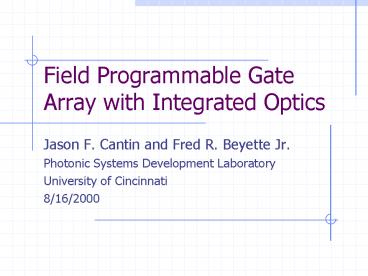Field Programmable Gate Array with Integrated Optics - PowerPoint PPT Presentation
1 / 26
Title:
Field Programmable Gate Array with Integrated Optics
Description:
provides massive parallelism and transfer rates not possible with electricity. can carry lots of information long ... Retinal Prosthesis. Problem & Motivation ... – PowerPoint PPT presentation
Number of Views:44
Avg rating:3.0/5.0
Title: Field Programmable Gate Array with Integrated Optics
1
Field Programmable Gate Array with Integrated
Optics
- Jason F. Cantin and Fred R. Beyette Jr.
- Photonic Systems Development Laboratory
- University of Cincinnati
- 8/16/2000
2
Light
- provides massive parallelism and transfer rates
not possible with electricity - can carry lots of information long distances with
little attenuation and noise - has interesting properties that can be exploited
for computing purposes
3
Light is even more useful with circuits
- We can combine optics with circuits
- Enhance the performance of optics
- Improve bandwidth and communication latency
between electronic systems - On a single chip
Optics
Logic
Memory
Pads
4
Some Applications
- Single-chip cameras
- Image processing systems
- Capture and compress images in real time
- Optical Memories
- Disk read heads, database filtering
- Retinal Prosthesis
5
Problem Motivation
- Wed like to do research with novel
optoelectronic chips - Chips are hard to develop
- Expensive ()
- Long lead time
- CAD tools are unavailable or expensive
- Typically the experimental optics are placed on a
separate chip
Wires
Logic
Optics
6
Custom chips can be prototyped using Field
Programmable Gate Arrays
- FPGAs are chips with uncommitted logic that are
programmable - A string of bits is loaded onto the chip to
define its behavior - Once, or at power-up
- Software defined hardware
- Dense enough to implement entire digital systems
- Processors, I/O controllers, etc.
7
Designing with FPGAs
- Fast and cheap because the FPGA does the job of a
custom chip - Designs can be specified in a high-level
language, and a compiler used to generate
low-level configuration data - FPGAs are available in all shapes, sizes, and
colors
8
Simple FPGA
I/O Blocks
Routing channel (Wires that can be Connected to
blocks)
Logic Block (Function can be defined by user)
Die
9
Our Idea
I/O Blocks
Routing channel
Structure same as a conventional FPGA, with
sensors and emitters inserted
Logic Block
Reconfigurable Sensor
Reconfigurable Emitter
Embedded RAM
10
Lots of sensors and emitters can be fabricated
with logic on a chip
- Optical detectors and temperature sensors are
made from reverse-biased diodes - Optical emitters made from suspended polysilicon
filaments (micro-heaters) - Pressure sensors and strain-guages are leveraged
from parallel-plate capacitors - Measure capacitance to determine displacement
11
Our first chip
12
Our first chip
Logic Block
2.2 mm
Detector
Sensor Block
Wires
Clock Driver
13
Crowbar
- Small 34 array of configurable elements
- Full-custom design
- 5,000 CMOS transistors
- 8 logic-blocks
- Look-up tables used for logic functions
- 4 sensor-blocks
- Each with a photodiode
14
Crowbar Logic-Block Characteristics
- 32 Possible 3-input logic functions
- Inputs can be selected from the 4 nearest
neighbors, and past outputs - One flip-flop with reset
- Maximum Delay of 19.3nS
15
Crowbar Logic-Block Structure
INPUTS (NS, NEWS, NEWS)
Configuration in
Clocks
Configure
3-input lookup table
Scan chain in
Test Mode
FF
User Reset
Scan chain out
OUTPUT
Configuration Out
16
Crowbar Logic-Block Layout
17
Crowbar Logic-Block Layout
Look-up table
Multiplexers
Flip-Flop
18
Crowbar Sensor-Block Characteristics
- 8 Selectable thresholds for the detector
- One flip-flop with reset
- Detector and Receiver
- 1Mhz maximum frequency
19
Photodiode
Photons
- PN Junction between the well and substrate
- Illumination creates electron-hole pairs in
semiconductor - In the depletion region, this creates a drift
current
5 volts
I-photo
P
N
N-type well
P-type Silicon Substrate
20
Optical Receiver Schematic
VDD
IN0
IN1
IN2
I_OPT
VREF
IREF
VDD
Programmable Voltage Reference
Photodiode Amplifier
Comparator
Light goes here
OUT_H
OUT_L
21
Crowbar Sensor-Block Structure
Configuration in
Clocks
Configure
Config. Optical
Receiver Detector
(3 bits ? 8 possible thresholds)
Scan chain in
Test
N, E, W, S, ClkA, ClkB
FF
User Reset
Scan chain out
OUTPUT
Configuration Out
22
Crowbar Sensor-Block Layout
23
Crowbar Sensor-Block Layout
Receiver
Photodiode
Flip-flop
Multiplexer
24
Added Bonus
- The Crowbar chip can be configured optically
- Entire pages of configuration data received at
once - Changing the configuration takes microseconds!
Spatial Light Modulator
Configuration Data
Crowbar chip
Board
25
Project Status
- Project began 2/25/2000
- Prototype design sent to factory on 5/30/2000
- First-silicon expected this month
- Concept paper in progress
26
Future Work
- CAD tool support for prototype
- Larger version with more sensors, more logic,
emitters and embedded RAM - Evaluating other types of sensors and emitters
(not just optical)































